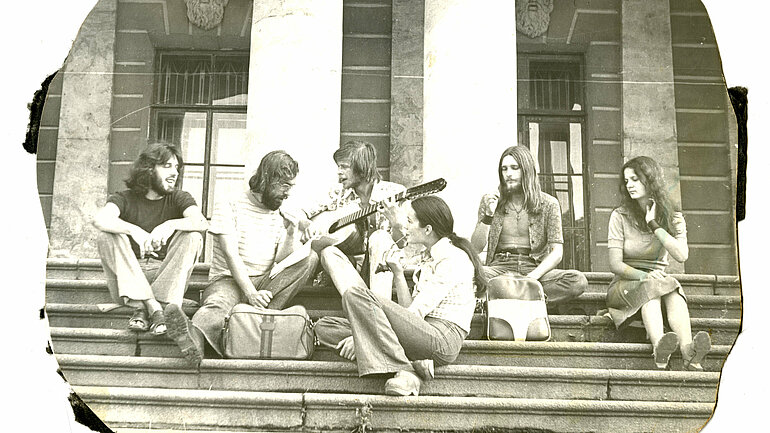“You were either a hippie or a member of socialist society”

Juliane Fürst spent 12 years studying Soviet hippies for her book Flowers Through Concrete. Based on interviews with eye-witnesses and research in KGB archives, she paints a vivid picture of a much-neglected movement. So who were the flowers that grew through concrete?

How did hippies in the Soviet Union differ from those in the West?
Let me turn the question around and explain how they were similar. The hippies were one of the first expressions of a truly global youth culture; they openly regarded themselves as part of an international movement and behaved accordingly. If we compare photos of hippies in Hyde Park in London with photos of hippies taken in Leningrad a few years later, for example, we see very little difference between them. There are some wonderful photographs from the USSR which clearly show the distinctive visual appearance and symbols of the hippies: the flowing hair, the flowered clothes, the flared trousers, the brightly coloured shirts. The Soviet hippies did well to capture this look despite all the shortages of these items on the Soviet market. But it wasn’t only about appearance. They were similar to their Western role models in their ethos as well: there was the music, the striving for a better world, both here and now and in a parallel world – in their own spiritual universe, whether they tuned in through religion or drugs. If we look at the differences, it becomes more complicated because we then have consider what happened to hippies when they tried to survive in a late socialist society. My theory is that Soviet hippies started by imitating the West but then developed their own characteristics in response to the circumstances in which they had to survive.
The hippies had a special and possibly ironic term for their own community – they called it the sistema, the system. What were its chief characteristics?
The hippie movement created a system which enabled it to survive. The major difference between Soviet and Western hippies is that the Soviet hippies coined a term – sistema – which then came to characterise their modus operandi. I wouldn’t say that they were well-organised, but they had rituals that made it easier for them to survive as a community within a system that really would have preferred them to disappear. Having a community is a strength in itself. But there was more to it than that: it was about connecting across the whole of the Soviet Union, being aware of their own history, and having a thoroughly ritualised agenda. The KGB – the Soviet security agency – took a great interest whenever hippies travelled and congregated anywhere in the Soviet Union. The hippies would gather on specific days at specific locations; everyone knew about them. All this “sovieticised” the hippies to the point where they were perfectly adapted to the official system. Not in the sense that they came to resemble the system, but they occupied the niches left by the system’s own weaknesses. By the end, they were so intermeshed with late socialism that when it disappeared, so did the hippies.
In the US, the hippies were an offshoot of the peace movement. How did the movement start in the Soviet Union?
In the Soviet Union, it really started with the music of the 1960s, by which I mean music from the West, mainly the Beatles but also the Rolling Stones and the Doors. Young people wanted to express the feelings that this music evoked – and to do so through their visual appearance. So they began to take an interest in who the band members were and very soon, they came across the hippie movement. Interestingly, the peace movement that emerged in response to the Vietnam War overlapped with the official Soviet position to some extent, so initially, there were some well-meaning articles about hippies in the Soviet press. The Soviet leadership wasn’t sure what to make of these young Westerners who were protesting against everything that the leaders themselves were opposed to, such as capitalism, materialism and the war in Vietnam, but who didn’t lend themselves to classification according to the Marxist socialist model. So there were these quite benign articles in the Soviet press, and some of them had an incredible influence on young people. Because of these numerous overlaps, many young Soviets did not see any conflict at first between being a hippie and living in Soviet society. However, as time went on, the antagonisms emerged, and with it came a clear anti-Soviet element within the Soviet hippie movement.

How did the Soviet Union react to the movement, given its relatively benign reaction at first?
The first article that was critical focused on home-grown hippies in Latvia and was published as early as 1969. From 1971, it was quite obvious that hippies were no longer tolerated by the Soviet regime; on the contrary, they were viewed as enemies of the socialist system. What bothered the Soviet authorities most of all was the way they looked – their visual appearance. In 1971, there was a big hippie demonstration in Moscow against the Vietnam War. Although opposition to American involvement in the Vietnam War was in line with the Soviet Union’s official policy, the demonstration itself was unauthorised; it may even have been instigated by the KGB. In any event, there were mass arrests. At first, the only consequence was that some of the leaders were sentenced to two weeks‘ community work, but a year later, many of those who had been arrested at the demonstration were conscripted into the army and sent to the Chinese border (which was a war zone at the time). The message was clear: no one was simply a hippie on the side any more. You were either a hippie or a member of socialist society. If you were a hippie, you lost your chance to study at university or find employment for which even a minimum of ideological conformity was required. Hippies became part of that generation which Boris Grebenshikov, the singer of the Leningrad band Aquarium, later described as yard workers and store workers. They were relegated to jobs that were so low-status that it didn’t matter if you had long hair and an un-Soviet attitude. Everyone had to have a job; that was the law. And there were various incidents which reinforced the impression among Soviet auhorities that hippies could potentially pose a serious threat to the Soviet order. In the Lithuanian city of Kaunas, for example, a long-haired young man named Romas Kalanta, poured petrol on himself and set himself on fire in May 1972 as a protest against the Soviet regime. The local hippies were immediately arrested or fled the city. On the day of Romas Kalanta’s funeral, large numbers of young people who sympathised with hippies came out on the streets and demonstrated for freedom – freedom for hippies and for Lithuania. This intermingling of national and youth cultural claims was deeply unsettling for the authorities. The riots in Kaunas lasted three days.
How were the hippies different from other subcultures such as dissidents and nationalists?
In my view, the hippies were dissidents too, certainly on a cultural level but in some ways politically as well. They simply expressed themselves differently. The Soviet hippie movement was one of the few genuinely Soviet phenomena in that it brought together members of diverse nationalities and groups from different Soviet republics and melded them into a community of shared values. Nationalism was rarely of interest to them, although many hippies later embraced national and nationalist ideas. If we look more closely at the hippie ideology in East and West, there are many аspects on which they were not too far from nationalist ideas: their affinity for absolute freedom, the authentic, the original. The “classic” Soviet dissidents were not popular among the hippies; they fiercely believed in withdrawal from politics. For Soviet hippies, dissidents were simply the obverse of Soviet authority: one side was in favour, the other against. They had a saying: while you argue [about politics], we sit by the river and let our hair grow. The fundamental principle was rejection of the system. And of course, that conflicted with the dissidents’ reform-oriented approach.
The interview was conducted by Elena Goerttler-Reck, trainee in communications at ZOiS.
Juliane Fürst is a historian at the Leibnitz Center for Contemporary History Research in Potsdam. There she researches youth, protest and subcultures in late and post-socialism.
Juliane Fürst, "Flowers through Concrete. Explorations in Soviet Hippieland" (2021), Oxford University Press.